Plant Profiles
Click on the first letter of the common name of the plant you wish more information about.
A | B | C | D | E | F | G | H | I | J | K | L | M | N | O | P | Q | R | S | T | U | V | W | X | Y | Z
R
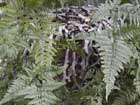
Rabbit's Foot Fern
Scientific Name: Davallia fejeensis
Growth Habit: A creeping evergreen perennial fern with a furlike covering on rhizomes that resemble rabbit's feet, forming plants growing to 10 inches tall and twice as wide. The leaves are finely cut and lancelike and grow to more than 12 inches long and half as wide.
Light: Grow in bright light but out of direct sun. May be grown in the home, under a tree or on a shady patio.
Feedings: Apply a 20-20-20 or similar fertilizer at one-half the recommended rate monthly March through October; none during the cooler months.
Water Needs: Prefers a moist soil. Water when the surface begins to dry.
Ease of Culture: Easy.
Propagation: Start plants by removing rhizomes from older clumps and rooting them in pots of soil.
Hardiness: Medium; prefers the warmer weather. Drops its leaves when temperatures dip below 50 degrees; severely damaged by frosts and freezing weather.
Major Problems: Scale insects and mealybugs may infest the stems and leaves. Control with natural sprays as needed following label instructions.
Pruning: Remove declining leaves during late winter as growth begins and as noted throughout the year. Periodically trim out-of-bounds rhizomes to keep an attractive compact plant.
Uses: An attractive foliage plant to display indoors in bright Florida rooms or atriums. Plants also may be set on the porch or patio if given adequate moisture and misted to provide humidity. Many gardeners like to display their plants in hanging baskets where the rhizomes cascade over the sides. Containers can be hung from the limbs of trees, from arbors or under eaves.
Florida Native: No; native to Fiji.
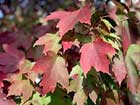
Red Maple
Scientific Name: Acer rubrum
Growth Habit: A deciduous rounded tree growing to 40 feet tall and 30 feet wide; leaves are medium green with three major lobes.
Light: Plant in full-sun locations.
Feedings: For the first three years after planting, feed trees once in March and in June with a general garden fertilizer; thereafter, obtains needed nutrients from decomposing mulch and nearby turf and shrub feedings.
Water Needs: Requires a moist soil for best growth. Needs watering every week or two during hot, dry weather.
Ease of Culture: Easy if you have adequate moisture.
Propagation: New trees can be started from seeds, cuttings and grafts.
Hardiness: Hardy.
Major Problems: Avoid unless you can maintain a moist soil. Most plantings can be damaged by caterpillars that feed in the tips of new shoots and borers in the ends of the branches. Pests seldom cause major decline. Surface roots compete with turf; use of mulch or ornamental ground covers may be best under the limbs.
Pruning: Remove or cut back competitive branches to keep a central leader; remove shoots from the base.
Uses: Red maples are good shade trees for moist soils. Use as backdrops for gardens and as street trees. They produce red flowers and fruits during January and February. The trees have yellow to orange leaves during November and December.
Florida Native: Yes.
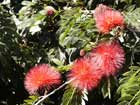
Red Powderpuff
Scientific Name: Calliandra haematocephala
Growth Habit: An evergreen with multiple arching branches forming a rounded shrub growing to 12 feet tall and wide. The leaves are deep green, consist of numerous leaflets and grow to 6 inches long and 2 inches wide.
Light: Plant in a full-sun location.
Feedings: Apply a general garden fertilizer once monthly in March, June and September if needed to encourage growth.
Water Needs: Drought tolerant. Water frequently until the roots of new plants grow into the surrounding soil. Thereafter, seasonal rains usually provide adequate moisture.
Ease of Culture: Easy.
Propagation: Start plants from seeds and cuttings.
Hardiness: Medium; foliage and stems can be damaged by freezing weather but plants normally grow back from buds near the ground.
Major Problems: Scale insects and mealybugs commonly feed on the stems and foliage, which can result in a black sooty mold fungus coating the foliage. Control these pest problems with an oil spray as needed. Thorn bugs also feed on the stems. Clusters of the insects usually can be hand-picked when noted.
Pruning: Powderpuff shrubs grow large and might need periodic pruning throughout the year to remain in bounds. A major renewal pruning to remove winter-damaged portions and to control plant size can be performed in late February or March as flowering declines.
Uses: Plant where there is plenty of room to grow as a space divider or a view barrier. Powderpuff shrubs also can be used as an accent feature near patios and to create distant focal points in the landscape. Plants produce a display of bright-red powderpufflike blossoms when there is little winter color December through March.
Florida Native: No; native to Bolivia.
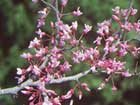
Redbud
Scientific Name: Cercis canadensis
Growth Habit: A deciduous rounded tree with an open branching habit growing to 25 feet tall and 20 feet wide. The leaves are heart-shaped and bright green, growing to more than 5 inches long and wide.
Light: Plant in full sun to lightly shaded locations.
Feedings: Apply a general garden fertilizer once each month in March and June for new trees up to three years after planting. Additional feedings are normally not needed as older trees obtain needed nutrients from decomposing mulches or nearby feedings of turf and shrubs.
Water Needs: Drought tolerant. Water until the root systems of new trees become established in the surrounding soil. Thereafter, seasonal rains normally provide adequate moisture.
Ease of Culture: Easy.
Propagation: Start trees by seeds or by grafting a named variety on a seedling root stock.
Hardiness: Hardy.
Major Problems: Caterpillars are occasionally found feeding on the foliage but can usually be ignored or handpicked from the trees. During late summer and early fall, redbud trees also may develop leaf spots, which seldom are controlled.
Pruning: Keep new trees to a single trunk until more than 4 feet tall; then branching can begin to create the canopy. Remove small shoots and crisscrossing stems as needed. Older limbs eventually may hang down over walkways and also need trimming.
Uses: An attractive accent tree with late-winter color. Plant along the street, walkway or patio. Limbs fill with small but numerous bark-hugging pink flowers during February and March. The trees also provide color when the large leaves turn bright yellow to orange in October.
Florida Native: Yes.
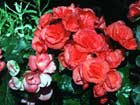
Reiger Begonia
Scientific Name: Begonia x hiemalis
Growth Habit: An evergreen perennial with asymmetrical leaves on upright to trailing plants; grows to 12 inches tall.
Light: Shade to filtered sun.
Feedings: Feed monthly with a 20-20-20 or similar fertilizer solution during active growth. Reduce feedings to every six weeks during slower growth.
Water Needs: Moisten when the surface soil begins to dry November through May. After flowering, let plants dry more between waterings.
Ease of Culture: Medium.
Propagation: Leaf or stem cuttings.
Hardiness: Tender.
Major Problems: The shoots start to decline and become susceptible to rot problems. Allow the soil and plant foliage to remain drier to prevent root and stem rots. Resume normal care as growth begins.
Pruning: Trim faded flower heads and older leaves as they develop. After flowering, remove declining stems as new shoots grow. Pinch out the tips of dominant new shoots to encourage branching.
Uses: Reiger begonias belong to a group that is often called the winter bloomers. Many are now available year-round with clusters of pink, yellow, orange, red or white blossoms. When added to your plant collection, they often resume the winter through spring blooming habits. Plant as accents in container gardens for the home and patio. Also use as annual color in flower beds or cluster along walkways. Most gardeners add the plants to the compost pile when they start to decline.
Florida Native: No; hybrids developed by Otto Reiger of Germany.
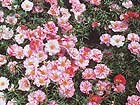
Rose Moss
Scientific Name: Portulaca grandiflora
Growth Habit: A spreading annual with small, rounded fleshy stems and leaves forming plants that grow to 6 inches tall and 18 inches wide.
Light: Plant in full-sun locations.
Feedings: Feed lightly with a general garden fertilizer monthly.
Water Needs: Drought tolerant; plant in well-drained soils and water only when the surface soil begins to dry.
Ease of Culture: Easy.
Propagation: Start new plants from seed.
Hardiness: Tender.
Major Problems: Plantings can be affected by nematodes in heavily infested soils. Also select only well-drained soils to avoid root rot problems. Some varieties close blooms when visited by bees or during the hot afternoon hours. Newer selections remain open throughout the day. Flowers last only a day, but plants have many buds.
Pruning: Remove stems that may be creeping into garden paths or competing with nearby plantings.
Uses: Rose moss, also called moss rose, is a warm-season annual that's planted March through October. It's best planted in a cluster, creating a carpet of color in flower beds and as an edging along walkways. It also can be used to fill hanging baskets and as a cascading border around the sides of planters. Plantings aoffer a wide range of bright pink, scarlet, orange, white and blends of blossoms. Newer selections offer both single and double blossoms.
Florida Native: No; native to South America.

